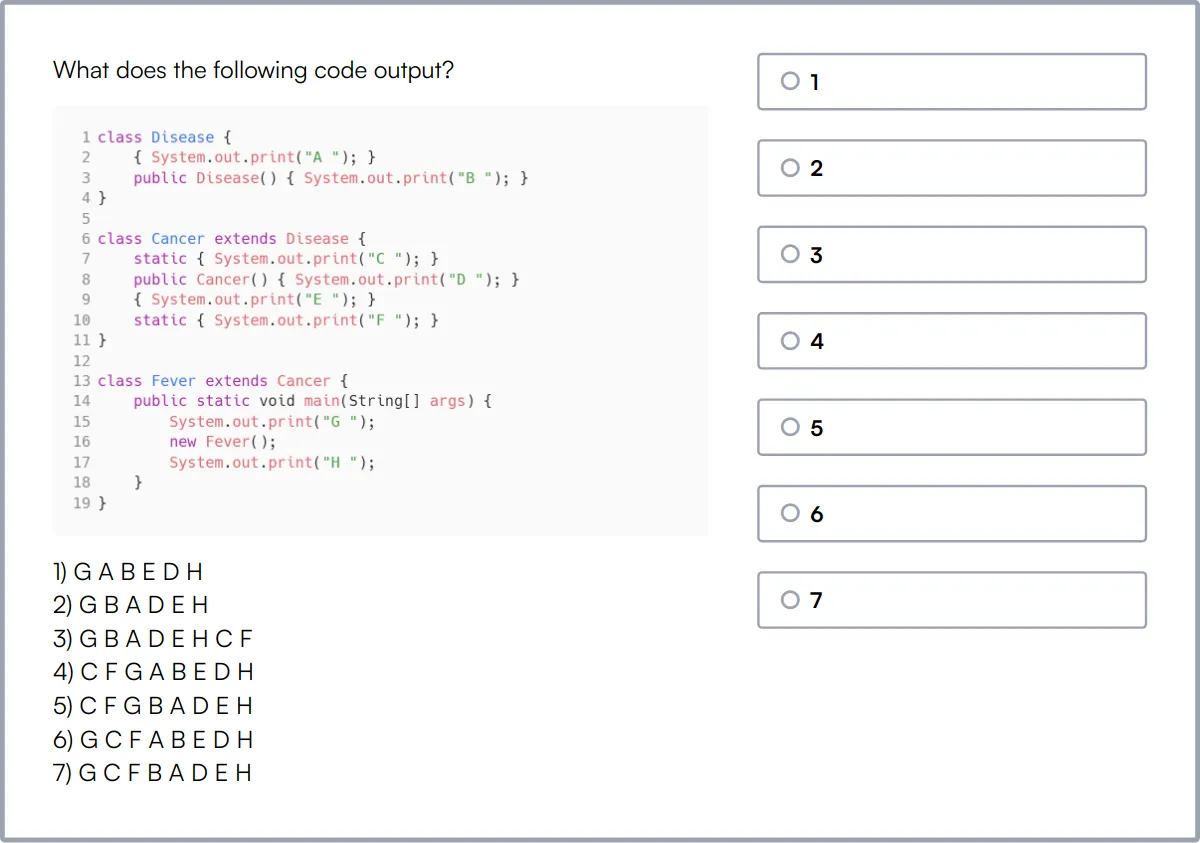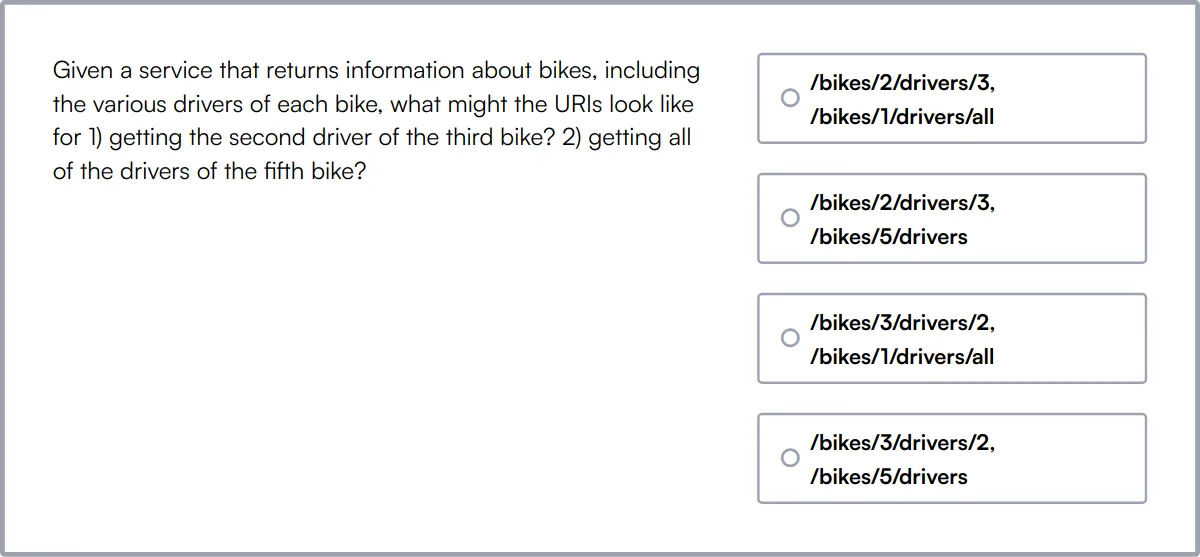Back end developers are the backbone of web applications and services. They focus on server-side logic, database management, and application integration, ensuring that the user's interactions are processed effectively.
Skills necessary for a back end developer include proficiency in server-side languages like Java, Python, and Ruby, and a strong understanding of database technologies such as MySQL, MongoDB, and SQL Server. They also need to be adept at problem-solving and debugging.
Candidates can write these abilities in their resumes, but you can’t verify them without on-the-job Back End Developer skill tests.
In this post, we will explore 8 essential Back End Developer skills, 10 secondary skills and how to assess them so you can make informed hiring decisions.
Table of contents
8 fundamental Back End Developer skills and traits
The best skills for Back End Developers include Database Management, Server-Side Languages, API Development, Version Control, Security Practices, Data Structures, Performance Optimization and Cloud Services.
Let’s dive into the details by examining the 8 essential skills of a Back End Developer.

Database Management
A back end developer needs to be proficient in database management. This involves designing, implementing, and maintaining databases to store and retrieve data efficiently. Whether it's SQL or NoSQL, understanding how to interact with databases is crucial for building robust applications.
For more insights, check out our guide to writing a Database Administrator (DBA) Job Description.
Server-Side Languages
Knowledge of server-side languages like Python, Java, Ruby, or Node.js is essential. These languages are used to write the logic that powers the back end of web applications. A back end developer uses these languages to handle requests, process data, and communicate with databases.
API Development
APIs (Application Programming Interfaces) are the bridges between different software systems. A back end developer must be skilled in creating and managing APIs to enable communication between the server and client-side applications. This includes RESTful and GraphQL APIs.
Check out our guide for a comprehensive list of interview questions.
Version Control
Using version control systems like Git is a must for any back end developer. It allows developers to track changes, collaborate with team members, and manage code versions effectively. This skill ensures that the development process is organized and that code can be rolled back if necessary.
Security Practices
Understanding security practices is critical for a back end developer. This includes knowledge of encryption, authentication, and authorization techniques to protect data and ensure that applications are secure from threats. Implementing security measures helps in safeguarding sensitive information.
For more insights, check out our guide to writing a Cyber Security Engineer Job Description.
Data Structures
A solid grasp of data structures is important for optimizing the performance of back end systems. This includes understanding arrays, linked lists, trees, and hash tables. A back end developer uses these structures to manage and organize data efficiently.
Performance Optimization
Performance optimization involves improving the speed and efficiency of server-side processes. A back end developer must be adept at identifying bottlenecks and optimizing code to ensure that applications run smoothly and can handle high traffic loads.
Check out our guide for a comprehensive list of interview questions.
Cloud Services
Familiarity with cloud services like AWS, Azure, or Google Cloud is increasingly important. A back end developer uses these platforms to deploy, manage, and scale applications. Understanding cloud services helps in leveraging their features for better performance and reliability.
10 secondary Back End Developer skills and traits
The best skills for Back End Developers include Containerization, Caching Mechanisms, Message Queues, Testing Frameworks, CI/CD Pipelines, Logging and Monitoring, Web Servers, GraphQL, ORM Tools and Microservices Architecture.
Let’s dive into the details by examining the 10 secondary skills of a Back End Developer.

Containerization
Knowledge of containerization tools like Docker and Kubernetes can be beneficial. These tools help in creating, deploying, and managing containerized applications, making it easier to maintain consistency across different environments.
Caching Mechanisms
Understanding caching mechanisms like Redis or Memcached can improve application performance. A back end developer uses these tools to store frequently accessed data in memory, reducing the load on databases and speeding up response times.
Message Queues
Familiarity with message queues like RabbitMQ or Kafka is useful for handling asynchronous tasks. These tools help in managing communication between different parts of an application, ensuring that tasks are processed efficiently.
Testing Frameworks
Proficiency in testing frameworks like JUnit, Mocha, or PyTest is important for ensuring code quality. A back end developer uses these frameworks to write and run tests, catching bugs early in the development process.
CI/CD Pipelines
Continuous Integration and Continuous Deployment (CI/CD) pipelines automate the process of testing and deploying code. A back end developer should be familiar with tools like Jenkins, Travis CI, or GitHub Actions to streamline the development workflow.
Logging and Monitoring
Implementing logging and monitoring tools like ELK Stack or Prometheus helps in tracking application performance and diagnosing issues. A back end developer uses these tools to gain insights into application behavior and ensure reliability.
Web Servers
Knowledge of web servers like Nginx or Apache is useful for configuring and managing server environments. A back end developer uses these servers to handle client requests and serve web content efficiently.
GraphQL
While RESTful APIs are common, understanding GraphQL can be advantageous. A back end developer uses GraphQL to create flexible and efficient APIs that allow clients to request exactly the data they need.
ORM Tools
Object-Relational Mapping (ORM) tools like Hibernate or Sequelize simplify database interactions. A back end developer uses these tools to map database tables to objects, reducing the amount of boilerplate code and speeding up development.
Microservices Architecture
Understanding microservices architecture can be beneficial for building scalable applications. A back end developer uses this approach to break down applications into smaller, independent services that can be developed, deployed, and scaled individually.
How to assess Back End Developer skills and traits
Assessing the skills and traits of a Back End Developer can be a challenging task. While resumes and portfolios provide a snapshot of a candidate's experience, they often fall short in revealing the depth of their expertise in areas like database management, server-side languages, and API development. To truly understand a candidate's capabilities, you need to go beyond traditional hiring methods.
Skills-based assessments offer a more reliable way to gauge a candidate's proficiency in key areas such as version control, security practices, performance optimization, and cloud services. These assessments can help you identify whether a candidate has the practical knowledge and problem-solving abilities required for your specific needs. Adaface on-the-job skill tests can significantly streamline this process, offering a 2x improved quality of hires and an 85% reduction in screening time.
Let’s look at how to assess Back End Developer skills with these 6 talent assessments.
MySQL Online Test
Our MySQL Online Test evaluates a candidate's proficiency in MySQL, focusing on their ability to design databases, write SQL queries, and implement MySQL features such as indexing and transactions.
The test assesses candidates on their knowledge of database design, SQL queries, normalization, and advanced MySQL features like stored procedures and triggers.
Successful candidates demonstrate a thorough understanding of MySQL operations, optimization techniques, and data manipulation capabilities.

Java Online Test
Our Java Online Test measures a candidate's grasp of core Java concepts, including object-oriented programming, exception handling, and working with databases.
This test evaluates Java syntax, semantics, data structures, and the use of the Collections framework, along with multi-threading and functional programming.
Candidates who score well are proficient in Java coding, understanding complex algorithms, and implementing efficient solutions.

REST API Test
The REST API Test assesses a candidate's ability to design and interact with RESTful APIs, focusing on API integrations and backend service design.
Candidates are tested on their understanding of REST principles, HTTP methods, authentication, and best practices in API design.
High-scoring individuals excel in creating scalable and secure APIs, demonstrating strong technical aptitude and coding skills.

Git Online Test
Our Git Online Test evaluates a candidate's knowledge of Git, covering repository management, branching, merging, and conflict resolution.
The test challenges candidates on their use of Git commands, branching models, and workflows essential for effective version control.
Candidates proficient in Git can effectively manage and collaborate on software projects, ensuring code integrity and continuity.

Cyber Security Assessment Test
The Cyber Security Assessment Test evaluates candidates on their ability to secure networks and handle cybersecurity threats, including network attacks and cryptography.
This test covers network security, cybersecurity attacks, web security, and data protection strategies to assess a candidate's ability to safeguard digital information.
Well-performing candidates demonstrate a comprehensive understanding of security protocols, risk assessments, and preventive cybersecurity measures.

Advance Networking in AWS Online Test
Our Advance Networking in AWS Online Test assesses a candidate's expertise in AWS networking, focusing on VPC, subnets, and network security.
The test evaluates knowledge of AWS-specific networking concepts such as route tables, internet gateways, and load balancers, crucial for designing scalable cloud architectures.
Candidates who excel in this test are adept at configuring and troubleshooting AWS network setups, ensuring efficient and secure cloud operations.
Summary: The 8 key Back End Developer skills and how to test for them
| Back End Developer skill | How to assess them |
|---|---|
| 1. Database Management | Evaluate a candidate's ability to design, implement, and maintain databases. |
| 2. Server-Side Languages | Assess proficiency in server scripting languages to build robust applications. |
| 3. API Development | Check understanding of RESTful services and ability to design effective APIs. |
| 4. Version Control | Review experience with tools like Git for code versioning and collaboration. |
| 5. Security Practices | Test knowledge of securing applications against common security threats. |
| 6. Data Structures | Examine ability to use appropriate data structures for problem solving. |
| 7. Performance Optimization | Assess skills in enhancing software performance and efficiency. |
| 8. Cloud Services | Determine familiarity with cloud platforms and services integration. |
NuxtJS Test
Back End Developer skills FAQs
What are the key skills to look for in a Back End Developer?
Key skills include Database Management, Server-Side Languages, API Development, Version Control, and Security Practices.
How can I assess a candidate's proficiency in Database Management?
Ask about their experience with SQL and NoSQL databases, and request examples of database schema design and optimization.
What server-side languages should a Back End Developer know?
Common languages include Java, Python, Ruby, PHP, and Node.js. Assess their experience with at least one of these.
How do I evaluate a candidate's understanding of API Development?
Review their experience with RESTful and GraphQL APIs, and ask for examples of APIs they have built or maintained.
Why is Version Control important for Back End Developers?
Version Control, like Git, helps manage code changes and collaboration. Assess their experience with branching, merging, and pull requests.
What security practices should a Back End Developer be familiar with?
Look for knowledge in data encryption, authentication, authorization, and common vulnerabilities like SQL injection and XSS.
How can I test a candidate's skills in Performance Optimization?
Ask about their experience with profiling tools, load testing, and techniques for optimizing database queries and server response times.
What is the role of CI/CD Pipelines in Back End Development?
CI/CD Pipelines automate testing and deployment. Assess their experience with tools like Jenkins, Travis CI, or GitHub Actions.

40 min skill tests.
No trick questions.
Accurate shortlisting.
We make it easy for you to find the best candidates in your pipeline with a 40 min skills test.
Try for freeRelated posts
Free resources



